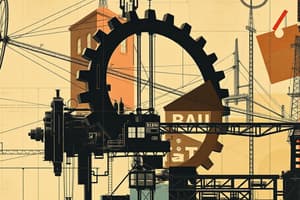Podcast
Questions and Answers
What is the primary focus of statics in engineering mechanics?
What is the primary focus of statics in engineering mechanics?
- The study of forces acting on moving bodies
- The examination of bodies in motion without reference to forces
- The investigation of motion caused by force applications
- The analysis of forces and their effects on bodies at rest (correct)
Which branch of dynamics specifically studies the causes of motion?
Which branch of dynamics specifically studies the causes of motion?
- Kinetics (correct)
- Kinematics
- Applied Mechanics
- Statics
What does the term 'inertia' refer to in mechanics?
What does the term 'inertia' refer to in mechanics?
- The property that resists changes to its state of motion (correct)
- The mass of an object
- The amount of force applied to move an object
- The speed of an object's movement
Which concept describes the unlimited expanse in which all material objects exist?
Which concept describes the unlimited expanse in which all material objects exist?
How is mass defined in the context of mechanics?
How is mass defined in the context of mechanics?
What is a characteristic of kinematics in dynamics?
What is a characteristic of kinematics in dynamics?
Which of the following statements is true about mechanics of deformable bodies?
Which of the following statements is true about mechanics of deformable bodies?
Which branch of mechanics does dynamics belong to?
Which branch of mechanics does dynamics belong to?
What is the unit of torque?
What is the unit of torque?
Which of the following is a scalar quantity?
Which of the following is a scalar quantity?
What is the conversion factor for converting 1 kilonewton (kN) to newtons (N)?
What is the conversion factor for converting 1 kilonewton (kN) to newtons (N)?
Which prefix represents a multiplication factor of $10^{12}$?
Which prefix represents a multiplication factor of $10^{12}$?
What physical quantity is represented by the unit Newton metre (N.m)?
What physical quantity is represented by the unit Newton metre (N.m)?
Which of the following statements is true about vector quantities?
Which of the following statements is true about vector quantities?
Which of the following is equal to 1 megajoule in joules?
Which of the following is equal to 1 megajoule in joules?
Which of the following definitions best describes force?
Which of the following definitions best describes force?
What is the primary reason the steel block moves slower than the wooden block when the same force is applied?
What is the primary reason the steel block moves slower than the wooden block when the same force is applied?
Which of the following best defines a body at rest?
Which of the following best defines a body at rest?
What characterizes a rigid body?
What characterizes a rigid body?
In mechanics, what is referred to as a continuum?
In mechanics, what is referred to as a continuum?
Which of the following is NOT one of the fundamental principles of mechanics?
Which of the following is NOT one of the fundamental principles of mechanics?
What is an essential characteristic of a deformable body?
What is an essential characteristic of a deformable body?
Which of the following best describes motion in a body?
Which of the following best describes motion in a body?
When defining a particle in mechanics, what assumption is made?
When defining a particle in mechanics, what assumption is made?
What is defined as non-coplanar non-concurrent forces?
What is defined as non-coplanar non-concurrent forces?
Which of the following accurately describes like parallel forces?
Which of the following accurately describes like parallel forces?
What is the main premise of the Principle of Superposition of Forces?
What is the main premise of the Principle of Superposition of Forces?
What do spatial non-concurrent forces represent in a system?
What do spatial non-concurrent forces represent in a system?
Which principle states that the nature of a force can change by shifting it along its line of action?
Which principle states that the nature of a force can change by shifting it along its line of action?
In the context of spatial concurrent forces, which example fits this definition?
In the context of spatial concurrent forces, which example fits this definition?
What is true about unlike parallel forces?
What is true about unlike parallel forces?
According to the Principle of Physical Independence of Forces, what occurs when multiple forces act on a particle?
According to the Principle of Physical Independence of Forces, what occurs when multiple forces act on a particle?
What is the expression for the resultant of three coplanar forces in equilibrium according to Lami's Theorem?
What is the expression for the resultant of three coplanar forces in equilibrium according to Lami's Theorem?
Which of the following best defines the moment of a force?
Which of the following best defines the moment of a force?
What characterizes a couple in physics?
What characterizes a couple in physics?
In the equation $M = P x x$, which variable represents the moment?
In the equation $M = P x x$, which variable represents the moment?
What does the arm of a couple refer to?
What does the arm of a couple refer to?
Which of the following options is correct regarding Bow's Notation?
Which of the following options is correct regarding Bow's Notation?
In a coplanar concurrent system, which statement is true regarding the vector diagram?
In a coplanar concurrent system, which statement is true regarding the vector diagram?
What type of couple is formed when two forces create a right turn effect?
What type of couple is formed when two forces create a right turn effect?
What does the Parallelogram Law of forces state about the resultant of two forces?
What does the Parallelogram Law of forces state about the resultant of two forces?
According to the Principle of Transmissibility, how can a force be perceived when acting on a rigid body?
According to the Principle of Transmissibility, how can a force be perceived when acting on a rigid body?
What does Newton's First Law of Motion imply about the state of a body?
What does Newton's First Law of Motion imply about the state of a body?
What is the relationship defined by Newton's Second Law of Motion?
What is the relationship defined by Newton's Second Law of Motion?
According to Newton's Third Law of Motion, what occurs when one body exerts a force on another?
According to Newton's Third Law of Motion, what occurs when one body exerts a force on another?
Which statement best describes Newton's Law of Gravitation?
Which statement best describes Newton's Law of Gravitation?
How can the weight of a body on Earth be defined using Newton's Law of Gravitation?
How can the weight of a body on Earth be defined using Newton's Law of Gravitation?
According to the Principle of Superposition of forces, what happens when equal and opposite collinear forces are added to a system?
According to the Principle of Superposition of forces, what happens when equal and opposite collinear forces are added to a system?
Flashcards
Engineering Mechanics
Engineering Mechanics
The application of mechanics principles to engineering problems.
Statics
Statics
Study of bodies at rest under forces.
Dynamics
Dynamics
Study of bodies in motion under forces.
Kinetics
Kinetics
Signup and view all the flashcards
Kinematics
Kinematics
Signup and view all the flashcards
Mechanics of Rigid Bodies
Mechanics of Rigid Bodies
Signup and view all the flashcards
Inertia
Inertia
Signup and view all the flashcards
Mass
Mass
Signup and view all the flashcards
Inertia
Inertia
Signup and view all the flashcards
Mass
Mass
Signup and view all the flashcards
Rest
Rest
Signup and view all the flashcards
Motion
Motion
Signup and view all the flashcards
Particle
Particle
Signup and view all the flashcards
Rigid Body
Rigid Body
Signup and view all the flashcards
Deformable Body
Deformable Body
Signup and view all the flashcards
Continuum
Continuum
Signup and view all the flashcards
Momentum
Momentum
Signup and view all the flashcards
Torque
Torque
Signup and view all the flashcards
Density
Density
Signup and view all the flashcards
Couple
Couple
Signup and view all the flashcards
Moment
Moment
Signup and view all the flashcards
Scalar Quantity
Scalar Quantity
Signup and view all the flashcards
Vector Quantity
Vector Quantity
Signup and view all the flashcards
Force
Force
Signup and view all the flashcards
Non-coplanar concurrent forces
Non-coplanar concurrent forces
Signup and view all the flashcards
Spatial Concurrent Forces
Spatial Concurrent Forces
Signup and view all the flashcards
Non-coplanar non-concurrent forces
Non-coplanar non-concurrent forces
Signup and view all the flashcards
Like parallel forces
Like parallel forces
Signup and view all the flashcards
Unlike parallel forces
Unlike parallel forces
Signup and view all the flashcards
Principle of Physical Independence
Principle of Physical Independence
Signup and view all the flashcards
Principle of Superposition
Principle of Superposition
Signup and view all the flashcards
Principle of Transmissibility
Principle of Transmissibility
Signup and view all the flashcards
Vector Diagram
Vector Diagram
Signup and view all the flashcards
Bow's Notation
Bow's Notation
Signup and view all the flashcards
Lami's Theorem
Lami's Theorem
Signup and view all the flashcards
Moment of a Force
Moment of a Force
Signup and view all the flashcards
Couple
Couple
Signup and view all the flashcards
Arm of a Couple
Arm of a Couple
Signup and view all the flashcards
Clockwise Couple
Clockwise Couple
Signup and view all the flashcards
Anticlockwise Couple
Anticlockwise Couple
Signup and view all the flashcards
Parallelogram Law
Parallelogram Law
Signup and view all the flashcards
Transmissibility Principle
Transmissibility Principle
Signup and view all the flashcards
Superposition of Forces
Superposition of Forces
Signup and view all the flashcards
Newton's 1st Law
Newton's 1st Law
Signup and view all the flashcards
Newton's 2nd Law
Newton's 2nd Law
Signup and view all the flashcards
Newton's 3rd Law
Newton's 3rd Law
Signup and view all the flashcards
Newton's Law of Gravitation
Newton's Law of Gravitation
Signup and view all the flashcards
Weight
Weight
Signup and view all the flashcards
Study Notes
Engineering Mechanics
- Mechanics is the branch of science that studies the state of rest or motion of particles and bodies under the action of forces.
- Applied mechanics focuses on systematically studying the laws of mechanics and their applications in engineering.
- Mechanics is a branch of science.
- Applied mechanics applies mechanics principles to engineering problems.
Branches of Mechanics
- Mechanics of rigid bodies (Engineering Mechanics): Involves static and dynamic analysis of rigid bodies.
- Statics: Studies bodies at rest and the forces acting on them.
- Dynamics: Studies bodies in motion.
- Kinetics: Examines the forces responsible for motion.
- Kinematics: Examines motion without considering the forces causing it.
- Mechanics of deformable bodies (Strength of materials): Focuses on the behavior of bodies that deform under stress.
- Mechanics of fluids: Studies the behavior of fluids.
Fundamental Concepts
- Space: The region encompassing all physical objects.
- Time: The measure of duration between events.
- Matter: Substance possessing weight and occupying space.
- Body: Matter bounded by a closed surface.
- Inertia: The property of a body to resist changes in its state of rest or motion.
- Mass: The amount of matter in a body, a measure of inertia.
- Rest: A body is at rest if its position relative to a reference point doesn't change over time.
- Motion: A body is in motion if its position relative to a reference point changes over time.
- Particle: An idealized body with negligible size and shape, used for simplifying analysis.
Fundamental Principles of Mechanics
- Parallelogram law of forces: If two forces are represented by adjacent sides of a parallelogram, their resultant is represented by the diagonal.
- Principle of transmissibility: A force acting at any point on a rigid body can be considered to act at any other point on its line of action.
- Principle of superposition of forces: Adding or removing equal and opposite collinear forces does not change the body's position.
- Newton's first law of motion: A body persists in its state of rest or uniform motion unless a force acts upon it.
- Newton's second law of motion: Acceleration of a body is directly proportional to the net force acting on it and in the direction of the net force (F=ma).
- Newton's third law of motion: For every action, there is an equal and opposite reaction.
- Newton's law of gravitation: The force of attraction between two bodies is proportional to the product of their masses and inversely proportional to the square of the distance between them (F = Gm1m2/r^2).
Systems of Units
- Fundamental units: Basic units used to measure length, mass, and time.
- Derived units: Units derived from fundamental units to describe other physical quantities.
- S.I. system of units: International system (m, kg, s) commonly used in engineering.
Scalar Quantities
- A scalar quantity is completely described by its magnitude only. Examples: Length, distance, mass, density, time, work, energy, temperature, speed.
Vector Quantities
- A vector quantity needs magnitude and direction to be completely defined. Examples: Displacement, velocity, acceleration, momentum, force, weight.
Studying That Suits You
Use AI to generate personalized quizzes and flashcards to suit your learning preferences.





